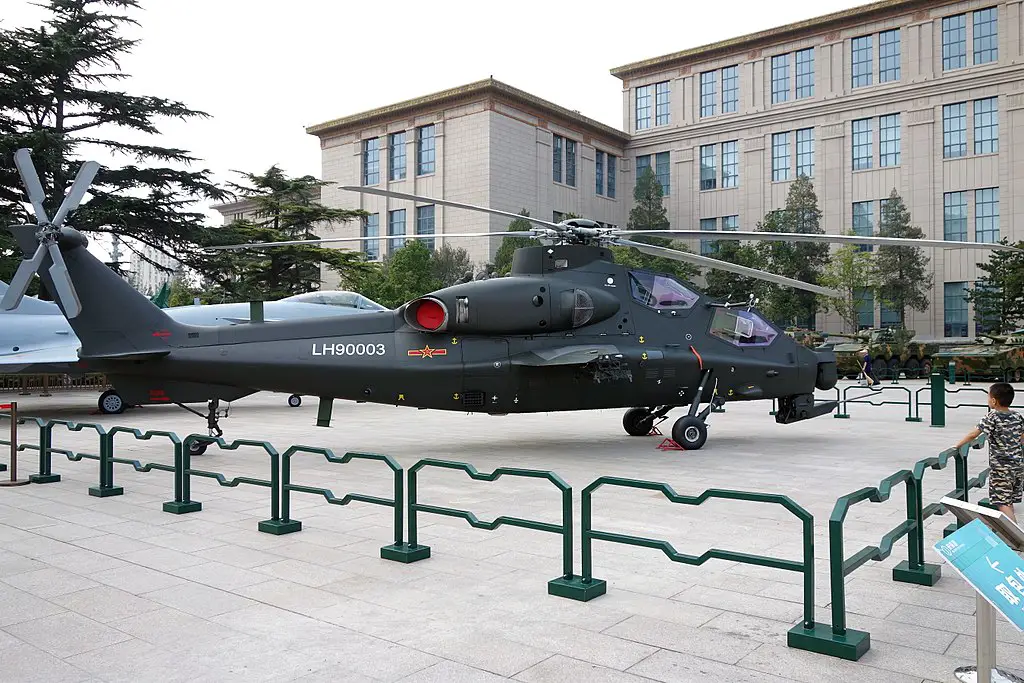The CAIC Z-10 also called WZ-10, is an attack helicopter developed by the People’s Republic of China. It is designed primarily for anti-tank warfare missions but has secondary air-to-air capability as well. It was designed by Kamov design bureau of Russia under a contract with the Chinese government. Kamov worked with the Chinese to establish base specifications, such as weight, speed and payload capacity after which they had full freedom to design the helicopter. Although designed in Russia the prototype construction, flight testing and further development was performed by the Chinese. Wu Ximing of the 602nd Research Institute, one of the Chinese top scientists involved in the 863 Program was publicly credited with being the chief designer of the Z-10, in an attempt to preserve the secrecy of the Kamov contract. Wu had earlier participated in the designs of the armed version of transport helicopters Z-8A and WZ-9.

The electronic warfare (EW) system of Z-10 is the first Chinese EW system that integrates the radar, radar warning receivers (RWR), laser warning receivers (LWR), electronic support measures (ESM) and electronic counter-measures (ECM) together. The system is designated YH-96 (Yu Huo), named after the YH radar. YH-96 is claimed to have a high interception rate of hostile signals, and in the fully automatic mode, it can automatically analyze the threat and launch different decoys and jamming signals accordingly. Alternatively, pilots can choose to launch decoys or jamming enemy sensors themselves. The helicopter also has an infrared jammer. One of the two primary fire control systems (FCS) is the electro-optical (optronics) system, which utilizes experience gained from earlier manufacturing of similar French and Israeli systems, combining the best of two, but only hardware wise. The software is completely indigenously developed by China.

In addition to the millimeter wave fire control radar and optronic FCS, the pilot of Z-10 has another FCS, the helmet mounted sight (HMS) designed by the 613th Research Institute. Additionally, helmet mounted displays (HMDs) were developed for Z-10, similar to the Honeywell M142 Integrated Helmet and Display Sighting System (IHADSS) used on AH-64 Apache. As with the case of optronic FCS, NVGs of Z-10 is developed based on experience gained in manufacturing similar French and Israeli systems. The Chinese millimeter wave (MMW) fire-control radar (FCR) adopts western approach of using a single antenna, similar to AN/APG-78 used for AH-64D Apache Longbow. The radar is designated as YH, short for Yu Huo (æµ´ç«), meaning bathing in fire.

The operation engine for the Z-10 is the domestic WZ-9, designed by the 602nd Research Institute. Wozhou-9 is the second least powerful engine out of the five tested for Z-10, but enjoys the advantage of no foreign built component. Another new engine, developed by China and Turbomeca, is the WZ16. With WZ-9 turboshafts, Z-10 can carry 16 HJ-10 missiles with maximum takeoff weight, but the payload is very heavy for the Z-10 and engines and potentially risky for flying, so 8 missiles with other weapons serve as the maximum useful payload. After new WZ16 engines are installed in the Z-10, it can carry 16 of them like AH-64. The 4-blade tail rotor is similar to the tail rotor of AH-64, with two pairs at unequal distance instead of 4 blades at the equal distance, and one of the main purposes of such arrangement was to reduce noise.

Due to its modular design concept, Z-10 can be armed with a wide variety of weaponry. The adaptation of Chinese GJV289A standard, the Chinese equivalent of the MIL-STD-1553B databus architecture, enables weaponry of both Russian and NATO origin to be adopted by Z-10. The largest caliber of gun carried by Z-10 is a 30 mm automatic gun, a Chinese development of the Russian 2A72 autocannon for aircraft use. One of the primary reasons to adopt the 2A72 30 mm gun for aerial use is its high reliability. The other autocannon that can be mounted on the Z-10 is the Chinese reverse-engineered 25 mm M242 Bushmaster adopted for helicopter use. The turret is flexible enough to incorporate configurations such as a single barrel machine gun and an automatic grenade launcher with calibers ranging from 30 mm to 40 mm, as in the AH-1 Cobra.

The stub wings have two hardpoints each for a total of four, each hardpoint being able to carry up to 4 missiles for a total of up to 16. The air-to-surface missiles deployed by Z-10 include the domestic HJ-8, HJ-9 and HJ-10 anti-tank missiles. The HJ-10 (ADK10) is thought to be similar to AGM-114 Hellfire and it has an anti-helicopter capability in addition to anti-tank capability. The main air-to-air missile deployed by Z-10 is TY-90, a missile specifically designed for use by helicopters in aerial combat. The Chinese FN-6 and QW series missiles can also be deployed, as with other non-Chinese MANPADs. TY-90 and MANPADs are often carried in pairs, with a total of 4 carried. When using larger air-to-air missiles such as PL-9 or similar missiles such as AIM-9 Sidewinder, the total number is reduced to 2. Z-10 can be armed with a wide variety of unguided rockets ranging from 20 mm to 130 mm caliber. The largest rockets tested were a type of 130 mm rocket that were carried on the hardpoints just as missiles are carried, while smaller caliber rockets were mounted in conventional rocket pods.














